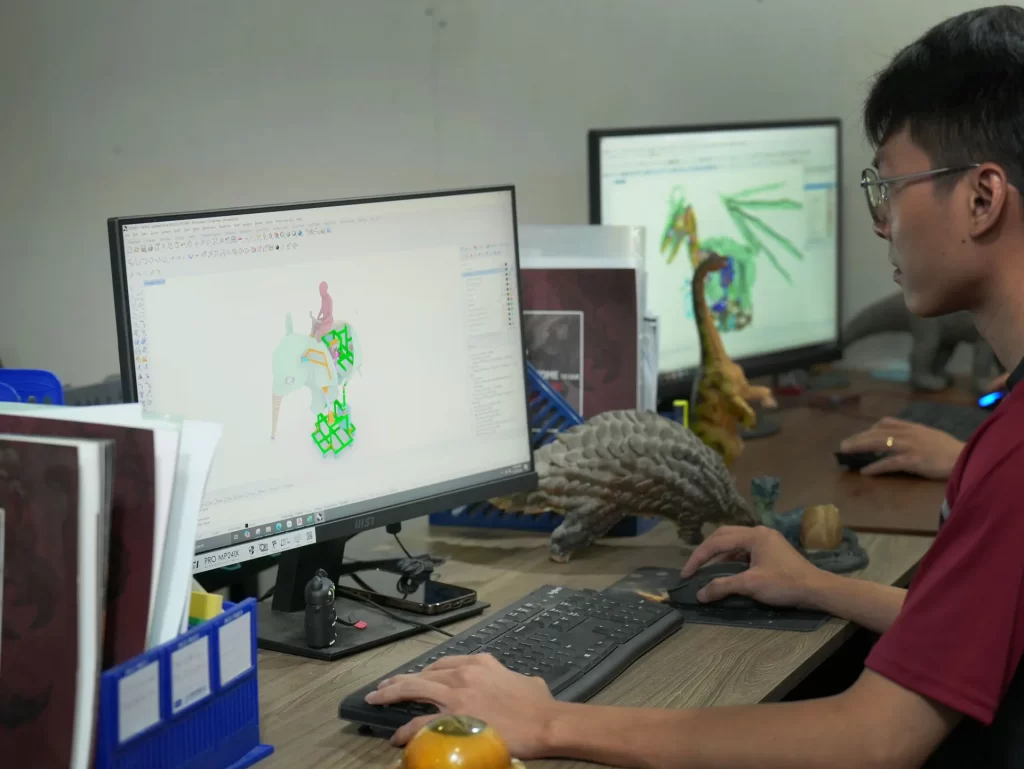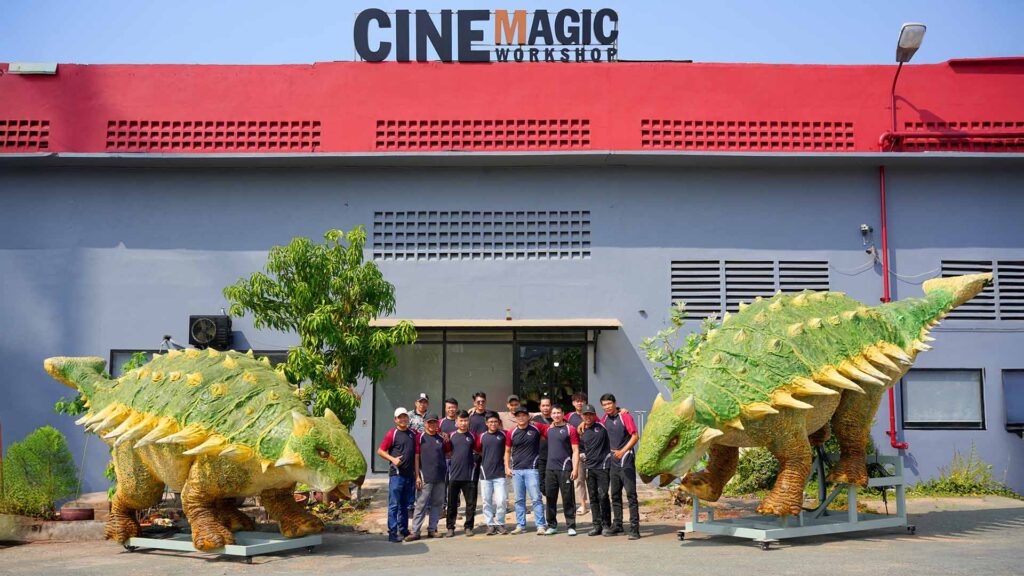If you’re curious about how much an animatronic costs, you’re not alone. These fascinating creations blend art and technology, captivating audiences everywhere. But before diving into the world of animatronics, it’s essential to understand what drives their prices and what options are available. This guide will break down the animatronic cost, helping you make informed decisions whether you’re an enthusiast or looking to invest in these impressive machines.
Key Takeaways
- Animatronic costs vary widely based on design and complexity.
- Custom animatronics are usually more expensive than pre-made ones.
- Materials and technology play a significant role in pricing.
- Maintenance and operational costs can add up over time.
- Researching reliable suppliers is crucial for a good purchase.
Understanding Animatronic Pricing
Animatronics are awesome, but figuring out how much they cost can be tricky. It’s not like buying a TV where you just look at the price tag. There are a bunch of things that affect the final cost, and it’s good to know what they are before you start planning your project. By May 10th, 2025, the market will have evolved quite a bit, so let’s break it down.
Factors Influencing Cost
Okay, so what makes one animatronic cost $5,000 and another $50,000? Here’s the deal:
- Complexity: A simple, static figure with a moving jaw will be way cheaper than a full-body, walking, talking robot. The more complex the movements and functions, the higher the price.
- Size: Bigger animatronics need more materials, stronger motors, and more labor. Makes sense, right?
- Materials: High-end silicone skin costs more than foam latex. Durable metal skeletons cost more than PVC frames. The materials used have a huge impact.
- Technology: AI integration, advanced sensors, and custom software all add to the cost. The more tech, the more you pay. Consider the technology integration carefully.
- Labor: Skilled artists, engineers, and programmers don’t work for free. The more specialized the skills needed, the higher the labor costs.
It’s important to remember that you often get what you pay for. Cheaper animatronics might cut corners on materials or craftsmanship, which can lead to problems down the road.
Types of Animatronics
Animatronics come in all shapes and sizes. Here are a few common types and their general price ranges:
| Type | Description | Price Range (USD) |
|---|---|---|
| Basic Static Figure | Simple figure with limited movement (e.g., head turn, jaw movement). | $1,000 – $5,000 |
| Intermediate Figure | More complex movements, such as arm and leg motions. | $5,000 – $20,000 |
| Advanced Full-Body | Full-body movement, speech capabilities, and advanced sensors. | $20,000 – $100,000+ |
| Custom Character | Unique, one-of-a-kind animatronics are designed to specific requirements. | $30,000+ |
| Themed Entertainment | Large-scale animatronics for theme parks and attractions. | $50,000 – $500,000+ |
Market Trends in 2025
In 2025, a few things are shaping the animatronics market:
- AI Integration: More animatronics are using AI for realistic movements and interactions. This is driving up costs but also improving performance. Cinemagic Workshop is at the forefront of innovative animatronic manufacturing and creative solutions, incorporating AI to bring characters to life with unprecedented realism.
- Sustainability: There’s a growing demand for eco-friendly materials and energy-efficient designs. This can add to the initial cost but save money in the long run.
- Customization: People want unique animatronics tailored to their specific needs. This is driving demand for custom design services.
- Increased Demand: Animatronics are being used in more industries, from entertainment to education to healthcare. This increased demand is putting pressure on prices. Keep an eye on the predicted cost trends to stay informed.
Cinemagic Workshop is known for its artistry and innovation. They focus on creating high-quality, reliable animatronics that stand the test of time. They’re a great example of a company that balances cost with quality, ensuring you get a product that’s worth the investment.
The Cost Breakdown of Animatronics
Materials and Components
Okay, so you’re wondering where all that money goes when you’re buying an animatronic? Well, a big chunk of it is in the actual stuff it’s made of. We’re talking everything from the metal skeleton to the silicone skin, and all the little gears and wires in between. The quality of these materials impacts the price. Think about it: cheap plastic versus high-grade silicone makes a huge difference in how realistic and durable the animatronic is. And that’s before you even get to the electronics!
- Actuators: These are the muscles of your animatronic, and better ones cost more. Pneumatic, hydraulic, or electric – each has a different price point.
- Microcontrollers: The brains of the operation. More complex movements need more processing power, which means a pricier microcontroller.
- Skins and coverings: Silicone, foam latex, fabric… the choice affects not only the look but also the cost and longevity.
It’s easy to underestimate the cost of raw materials. A seemingly small detail, like using a specific type of paint for realistic weathering, can add significantly to the overall expense. Don’t skimp here; quality materials mean a longer-lasting, more impressive animatronic.
Labor and Craftsmanship
Don’t forget the human element! Animatronics aren’t just assembled by machines; they’re brought to life by skilled artists and engineers. Sculpting, molding, painting, wiring – it all takes time and talent. The more complex the animatronic, the more hours of labor are involved, and that translates directly into cost. Cinemagic Workshop is known for its artistry, ensuring each animatronic is crafted with hyper-realistic detail. You’re not just paying for a product; you’re paying for expertise and passion.
Technology Integration
This is where things can get interesting (and expensive!). Are we talking basic movements, or are we talking AI-powered reactions and voice integration? The level of technology involved plays a huge role in the final price. Simple Halloween animatronics might just have a few basic movements triggered by a sensor, but a sophisticated figure could have facial recognition, respond to voice commands, and even learn from its interactions.
Here’s a quick look at some tech costs:
The more advanced the tech, the more you’ll pay. Cinemagic Workshop is known for its innovative animatronic manufacturing and creative solutions. They bring stories to life with precision, passion, and artistry. We transform imagination into unforgettable creations, delivering experiences that captivate audiences worldwide.
- Programming: Complex routines require skilled programmers.
- Sensors: From simple motion detectors to sophisticated cameras, sensors add to the cost.
- Power: Don’t forget the cost of powering all this tech! High-efficiency systems can save money in the long run.
Custom vs. Pre-Made Animatronics
Animatronics are awesome, right? But deciding whether to go with a custom build or a pre-made one can be tricky. Both have their pros and cons, and the best choice depends on what you need and what you’re willing to spend. Let’s break it down.

Custom Animatronics
Advantages of Custom Designs
Okay, so custom animatronics are where you get to let your imagination run wild. Think about it: you can have something unique. Here’s why people go custom:
- Uniqueness: You’re not stuck with what’s already out there. You get something one-of-a-kind.
- Specific Needs: Maybe you need an animatronic that fits a weird space or performs a very specific action. Custom is the way to go.
- Higher Quality Potential: You can choose top-notch materials and craftsmanship. Companies like CineMagic Workshop are known for their artistry and attention to detail, ensuring your custom piece is built to last.
Custom designs let you control every aspect of the animatronic, from its appearance to its movements. This level of control is invaluable if you have a very specific vision or need to meet particular requirements.
Cost Comparisons
Alright, let’s talk money. This is where things get real. Pre-made animatronics are almost always cheaper upfront. But don’t jump to conclusions just yet. Here’s a quick comparison:
| Feature | Pre-Made Animatronics | Custom Animatronics |
|---|---|---|
| Initial Cost | Lower | Higher |
| Design Control | Limited | Full |
| Uniqueness | Low | High |
| Maintenance | Standard | Potentially Higher |
| Long-Term Value | Can Vary | Potentially Higher |
So, while the initial cost of a custom animatronic is higher, the long-term value might be better if you need something that lasts and stands out. Plus, you’re paying for expertise and personalized service.
Use Cases for Each Option
Okay, so when should you go custom, and when is pre-made the better choice? Here are some scenarios:
- Pre-Made is Great For:
- Halloween decorations
- Basic haunted houses
- When you’re on a tight budget
- Custom is the Way to Go For:
- Theme parks
- Museum exhibits
- High-end haunted attractions
- When you need something truly special
If you need something off-the-shelf and budget-friendly, pre-made is fine. But if you want something that wows people and perfectly fits your vision, custom is the way to go. Just remember to factor in the higher initial cost and potential maintenance.
Maintenance and Operational Costs
Alright, so you’ve got your animatronic. Awesome! But the fun doesn’t stop there. Just like a car or any other complex piece of machinery, animatronics need regular care and feeding. Let’s break down what you can expect in terms of maintenance and operational costs.
Routine Maintenance Expenses
Think of this as your animatronic’s check-up. Regular maintenance is key to keeping things running smoothly and preventing bigger, more expensive problems down the road. What does this look like?
- Lubrication: Joints, gears, and moving parts need to be lubricated regularly. The type of lubricant will depend on the specific animatronic, so check your manual. Neglecting this can lead to increased friction, wear and tear, and eventually, failure.
- Cleaning: Dust, dirt, and debris can wreak havoc on sensitive components. Regular cleaning, especially of sensors and electronic parts, is a must. Use appropriate cleaning solutions and methods to avoid damage.
- Inspection: A visual inspection should be part of your routine. Look for loose wires, frayed cables, worn parts, or anything that just doesn’t look right. Catching these issues early can save you a lot of headaches.
- Software Updates: If your animatronic has software or firmware, keep it updated. Updates often include bug fixes, performance improvements, and new features. Outdated software can lead to glitches and compatibility issues.
Ignoring routine maintenance is like ignoring that weird noise your car is making. It might go away on its own, but it’s more likely to turn into a major repair bill. Regular maintenance is an investment in the longevity of your animatronic.
Repair and Replacement Costs
Even with the best maintenance, things can still break. Parts wear out, accidents happen, and sometimes, technology just fails. Be prepared for repair and replacement costs. The cost of animatronic parts can vary widely depending on the complexity and rarity of the component.
Here’s a rough idea of what you might encounter:
Animatronics can be power-hungry beasts, especially the larger, more complex ones. Energy consumption is an ongoing operational cost that you need to factor in. Here’s what to think about:
- Motor Efficiency: Look for animatronics with energy-efficient motors. Servo motors, for example, are generally more efficient than pneumatic or hydraulic systems.
- Idle Power: Even when an animatronic isn’t actively moving, it might still be drawing power. Check the idle power consumption and consider using power strips with switches to turn off power completely when not in use.
- Lighting: If your animatronic has lighting effects, LED lighting is a much more energy-efficient option than traditional incandescent bulbs.
- Automation: Smart automation can help reduce energy consumption. For example, using sensors to activate the animatronic only when someone is present can save a lot of power.
Consider the long-term costs. While a cheaper animatronic might seem appealing upfront, it could end up costing you more in the long run due to higher maintenance and energy consumption. Cinemagic Workshop focuses on building animatronics that are not only visually stunning but also engineered for reliability and efficiency.
Where to Buy Animatronics
So, you’re ready to buy an animatronic? Awesome! But where do you even start looking? It can feel overwhelming, but let’s break down some of the best places to find the perfect addition to your collection or project.
Reputable Manufacturers
Going directly to a manufacturer often means higher quality and more customization options. These companies usually specialize in animatronics and have years of experience crafting them. You’re not just buying a product; you’re investing in craftsmanship and expertise. Choosing a reputable manufacturer ensures you get a reliable and well-built animatronic.
- Benefits of Choosing a Manufacturer:
- Direct communication and support.
- Customization possibilities.
- Higher quality materials and construction.
CineMagic is a reputable animatronic manufacturer in Vietnam
Working with a manufacturer like Cinemagic Workshop can give you peace of mind. They’re known for their innovative designs and attention to detail, turning imagination into unforgettable creations. They bring stories to life with precision, passion, and artistry. It’s worth checking out their animatronic manufacturer services.
Online Marketplaces
Online marketplaces can be a mixed bag. You’ll find a huge range of options, from individual hobbyists selling their creations to larger companies listing their products. The prices can be very competitive, but it’s important to do your research and read reviews carefully. Look for sellers with established reputations and clear return policies. You can find great deals, but buyer beware!
- Things to Consider When Buying Online:
- Seller ratings and reviews.
- Shipping costs and return policies.
- Product descriptions and photos.
Local Suppliers
Don’t forget to check out local suppliers! This could include special effects shops, haunted house supply stores, or even prop rental companies. Buying locally allows you to see the animatronic in person before you buy it, and you can often get personalized advice and support. Plus, you’re supporting local businesses!
- Advantages of Local Suppliers:
- In-person inspection of products.
- Local support and expertise.
- Supporting your community.
Finding the right place to buy your animatronic is a big step. Take your time, do your research, and choose a supplier that you trust. Happy hunting for Halloween 2025 animatronics!
Financing Your Animatronic Purchase
So, you’re ready to take the plunge and buy an animatronic! That’s awesome. But before you max out your credit cards, let’s talk about how to pay for these amazing creations. It’s not always cheap, but with a little planning, you can make it happen. Think of it like this: you’re not just buying a prop; you’re investing in an experience. And like any investment, it needs a solid financial strategy.
Budgeting for Your Project
Okay, first things first: figure out exactly how much you can spend. Don’t just guess; sit down and look at your finances. What’s coming in, what’s going out, and what can you realistically set aside for your animatronic? Be honest with yourself. It’s better to start small and upgrade later than to go broke trying to get the biggest, fanciest animatronic prop right away.
Here’s a simple way to break it down:
- Determine your total available budget: This is the maximum amount you can allocate to the project.
- Research average animatronic costs: Get a sense of the price range for the type of animatronic you want.
- Factor in additional expenses: Don’t forget about shipping, installation, and potential maintenance costs.
Financing Options Available
Alright, so maybe your savings account isn’t quite overflowing. No worries! There are other ways to finance your animatronic dreams. Here are a few options to consider:
- Loans: Banks and credit unions might offer personal or business loans. Shop around for the best interest rates and terms.
- Credit Cards: Use with caution! Credit cards can be a convenient way to pay, but the interest rates can be killer if you don’t pay them off quickly.
- Payment Plans: Some animatronic manufacturers, like Cinemagic Workshop, might offer payment plans. It’s always worth asking!
Financing can be tricky, so make sure you read the fine print and understand all the terms and conditions before signing anything. It’s always a good idea to consult with a financial advisor if you’re unsure about the best approach for your situation.
Grants and Funding Opportunities
Did you know that there are grants and funding opportunities out there for creative projects? It’s a long shot, but it’s worth looking into, especially if your animatronic has an educational or artistic purpose. Check out arts councils, foundations, and even government agencies. You never know what you might find. Securing a grant can significantly ease the financial burden of your animatronic purchase.
Here’s where to start looking:
- Local Arts Councils: These organizations often provide grants to support local artists and creative projects.
- Private Foundations: Many foundations focus on specific areas, such as education, the arts, or technology. Research foundations that align with your project’s goals.
- Government Agencies: Check with your local, state, and federal government agencies for potential funding opportunities.
And remember, companies like Cinemagic Workshop are always a good resource for advice, even if they don’t directly offer grants. They’ve been in the industry for a while and might know about opportunities you haven’t considered. They’re known for their craftsmanship and industry leadership, so it’s worth reaching out!
The Future of Animatronics
Emerging Technologies
Okay, so what’s next for animatronics? It’s not just about making things move; it’s about making them alive. We’re talking serious advancements. Think AI that learns and adapts an animatronic’s performance in real-time. Imagine a character that can respond to the audience! Also, haptic feedback is getting better, so you might be able to feel textures on an animatronic. It’s wild. Universal is already pushing boundaries with robotics, as seen in their cutting-edge technology at attractions.
- AI-driven behavioral adaptation
- Advanced haptic feedback systems
- Integration of augmented reality for enhanced experiences
The push towards more realistic and interactive animatronics is fueled by both technological advancements and consumer demand for immersive experiences. This means more sophisticated designs, materials, and programming.
Predicted Cost Trends
Here’s the deal: costs are a mixed bag. Some things will get cheaper, others, not so much. As tech like 3D printing becomes more common, creating custom parts will be more affordable. But, the high-end stuff – the AI, the advanced materials – that’s probably going to stay pricey. It depends on the complexity of what you’re after. For example, the rise of immersive wellness experiences may drive demand for specialized animatronics, impacting overall costs.
| Component | 2025 Cost Trend | Reason |
|---|---|---|
| Basic Mechanics | Decreasing | Increased automation in manufacturing |
| Advanced AI | Increasing | Higher demand, specialized development |
| Custom Materials | Stable | Material costs remain relatively constant |
Impact on Industries
Animatronics aren’t just for theme parks anymore. They’re popping up everywhere! Education, healthcare, even retail. Think about lifelike training dummies for medical students or interactive displays in museums. The possibilities are pretty much endless. And as the tech gets better, you’ll see even more industries jumping on board. Companies like Cinemagic Workshop, with their artistry and innovation, are leading the way in transforming imagination into reality. They’re a great example of how craftsmanship and technology can come together to create unforgettable experiences. They are passionate Vietnamese creators obsessed with monsters. They bring stories to life with precision, passion, and artistry. We can expect to see more of this in the future.
- Healthcare: Realistic patient simulators for training.
- Education: Interactive museum exhibits and learning tools.
- Retail: Engaging displays and customer service robots.
As we look ahead, animatronics are set to become even more amazing. With new technology, these lifelike robots will be smarter and more interactive than ever before. Imagine walking into a theme park and seeing robots that can talk and move just like real people! If you want to learn more about the exciting future of animatronics, visit our website today!
Wrapping It Up
So, there you have it! Understanding the costs of animatronics can feel a bit overwhelming, but it’s really about knowing what you want and what fits your budget. Whether you’re a hobbyist or looking to invest in something more serious, there’s a range of options out there. Just remember to do your homework and consider factors like quality and safety. If you’re curious about where to start, Cinemagic Workshop is a great place to check out. They’ve got a solid reputation for making high-quality animatronics that won’t break the bank. Happy animatronic hunting!
Read more: How Expensive Are Animatronics? A Comprehensive Guide to Costs and Value


